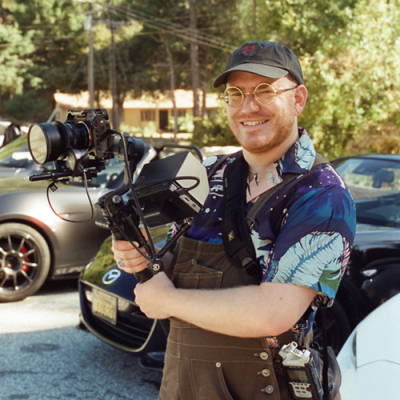Episode notes
Keith Phipps and Nathan Rabin of The AV Club stop by to sift through pop culture and present their picks, which include the Apple Records Box Set, a new cut of the classic film Metropolis, A Book of Jean’s Own! from The Onion columnist Jean Teasdale, a DVD set of The Six Million Dollar Man and the documentary Best Worst Movie.
JESSE THORN: It’s the Sound of Young America, I’m Jesse Thorn. From time to time we check in with our pals at the AV Club to help us find the diamonds among the quartz in the world of pop culture. Joining us this time around Nathan Rabin and Keith Phipps. Gentlemen, welcome back to The Sound of Young America, always a pleasure to have you on the show.
KEITH PHIPPS: Thank you for having us.
NATHAN RABIN: Thanks for having us.
Click Here For a Full Transcript of Our Interview.
JT: Keith, let’s talk about the new box set of Apple Records’ recordings. This is the record label made famous, of course, by The Beatles, but also home to a number of other artists. In fact, I just the other day interviewed Ronnie Spector and played a great record that she recorded for Apple Records. Let’s hear a clip of “My Sweet Lord” as recorded by Billy Preston.
Keith, this is a very interesting and specific niche of the history of popular music. What did you really like about it?
KP: I’m still digging my way through all 17 discs of it, to be honest. What I’ve heard is kind of – – the results are kind of odd. Apple was formed toward the end of The Beatles’ existence and what we have here is kind of the children of divorced parents. The label carried on for a little while after the band, and it didn’t necessarily have an identity beyond The Beatles or one of The Beatles or some pairings of The Beatles like this. You get amazing classics like Badfinger, No Dice, and Straight Up; sort of these cornerstones of power pop; and interesting albums by a singer named Mary Hopkin who everyone liked and had a few hits, and Billy Preston who was one of many “fifth Beatles” and also recorded a few albums for them. But you also get The Radha Krsna Temple – – you get James Taylor’s first album next to things like the Radha Krsna Temple recordings.
NR: Though it does kind of invalidate the whole project that it does not have Sgt. Pepper’s Lonely Hearts Club Band the Movie: The Soundtrack, just because it had nothing to do with The Beatles and came out many, many years later. I find that to be pretty problematic in its own right.
KP: It was actually on Casablanca records, if I’m not mistaken.
NR: That’s true.
JT: Nathan Rabin, let’s talk about one of your pseudo-colleagues at The Onion, Maria Schneider, who for many years has written this character for The Onion called Jean Tisdale, who is – – I don’t even know how to describe her. How would you describe the sorry sad sack that is Jean Tisdale?
NR: She’s The Onion’s human interest columnist. She writes about goofy day to day sorts of things. Underneath this cheery façade there’s just this agonizing sadness. Her column is sort of about the everyday tragedy of life. A review on Amazon referred to it as it as sort of a deep despair with a candy coated shell. And that’s definitely something that comes out a lot fuller in a book of Jean’s own, which is the first Onion book to be an actual comedy book and not just straight up news reprints.
JT: Keith, let’s talk a little bit about one of the greatest films ever made, Metropolis, which is out in a new version on DVD. Because this film was made so early in the history of film, it has been released and re-released in about a dozen trillion different versions, featuring different footage and different types of transfers and different re-masters and so on and so forth. What’s special about this new version?
KP: It’s quite watchable. The first time I saw Metropolis was on a VHS tape I bought from K-Mart, which had no soundtrack to it whatsoever; and every other frame seemed to be half-black and half-white with some blotches moving in the middle. This was a vast improvement over the versions that most of us have seen over the years. They found almost a half hour of additional footage somewhere in the vaults in Buenos Aires of all places. It’s as close to a definitive version as you’re going to get of this film. What I like about this version is that the extra footage really fills it out in some interesting ways. The plot feels smoother; it makes more sense just as a narrative. And the pace feels a little bit better as well. It’s one of those instances where adding footage to a movie actually makes it feel like it moves faster.
JT: Now what is the nature of this footage that was found in a vault in Buenos Aires? Is this stuff that nobody had ever found? Who cut this from the movie originally? How did it get cut out of the movie originally? What’s the story with it?
KP: Simple version of it, and it’s the only version I understand myself, is that the film premiered in Berlin. It was – – if not the most expensive film made in Germany at the time, close to it – – and it did not do very well. It premiered to much fanfare but very little audience interest. Before it really played anywhere else, I believe even in Germany, it was pulled from theaters and cut significantly. What we’ve seen over the years has been variations on the version that circulated after that, which was much shorter; I believe made shorter still for some releases. So this is as close to the original of what you would see on premiere night in Berlin as we’re gonna get, I believe. Who knows, though, because people said that in 2002 and suddenly there’s a half hour; so maybe there’s hours and hours of more footage of Metropolis waiting to be seen.
NR: They also restored the diamond smuggling subplot that they cut from the original version for time.
KP: Yeah, that was weird. And the bumbling comic duo.
JT: I didn’t remember – – all the versions that I had seen did not have Mr. Bean in them.
KP: That’s true, or that strange musical number. That was a real shock.
JT: Nathan Rabin, let’s talk about this documentary called Best Worst Movie. I met the director the other day, this guy named Michael Stephenson, a really nice fellow. He as a child was in this movie called Troll 2. In fact, I think we should take a listen to a clip from the documentary Best Worst Movie.
Troll 2 is a movie so spectacularly horrible that it has attracted quite a cult following. It’s interesting to think of the folks who made something so horrible coming back to it. What did you enjoy about watching this documentary with people revisiting what may be the low artistic point in their careers?
NR: I actually watched this before I watched Troll 2, and I wish that the order was reversed. You watch Troll 2 and you think, “My god, how on Earth did this film ever get made?” There’s a sort of cognitive dissonance that somehow this thing exists which should not exist on any level. There’s all sorts of weird incongruities; for one thing it doesn’t have anything to do with Troll. It also does not have any actual trolls in it; it’s all about goblins. And you think “How on Earth did this get made? Who are the lunatics that made this?”
KP: It’s actually not a movie, it’s a hologram.
NR: If you didn’t have concrete evidence you’d think this was some bizarre hallucination. A lot of it is a bizarre anti-vegetarians screed. I guess a screenwriter hated vegetarians so the bad guys are these goblins – – not trolls, it should be noted – – who are vegetarians who eat half-human, half-plant creatures that they create. I’m not the world’s foremost expert on vegetarianism or veganism, but I would imagine if something was part human it probably would qualify as meat. So you wonder, “Who are these people? How did this happen?” Just this giant question mark, and this answers all of those questions in a really, really satisfying way. The thing that is amazing is that they’re all crazier than you would imagine.
The lead actor, the father, was this dentist. On one level he’s kind of normal guy, he never really did a lot of acting outside of Troll 2; it was not his gateway to starring roles in big studio movies. On one hand he’s kind of a normal showboating sort of fellow, but he also has a pathological need for validation and for attention. They take him to the horror convention, and it’s this really tragic, comic scene where he’s just sitting there waiting for people to pay attention to him and they never do. There’s this moment of incredible irony where he’s talking about some other people and he says, “Man, can you imagine what that would be like, to be basking in the glow of something you did 20, 25 years ago?” It’s like, yes, we’re watching you right now; that’s exactly what you’re doing.
JT: Keith, one of your picks is one that I was a little surprised with when I saw it. You tend to be a classy type fella, and your final pick was the complete series on DVD of The Six Million Dollar Man. Does The Six Million Dollar Man have anything to teach us, show us – – any artistic value 30 years after it finished its run?
KP: I think short answer, yes, even if it only applies to me. This was my favorite show when I was four or five. I was really into The Six Million Dollar Man, and then as we’ve seen TV show after TV show reappear on DVD I’d think yeah, I’d like to see The Six Million Dollar Man, why can’t I watch The Six Million Dollar Man? We’re 15 years into this DVD thing and there’s no Six Million Dollar Man, and suddenly I get the press release for every episode of The Six Million Dollar Man and I request it.
It’s a little overwhelming to revisit it, because I find I don’t have the patience for the shows that I used to enjoy when I was four. It’s not that my attention span has gotten shorter, it’s just that this thing is paced like you wouldn’t believe. It’s so much footage of just the hero walking around, as was the style at the time in 70’s TV shows. You couldn’t go from one destination to the other without showing the audience every step of the way, usually to the company of some sort of bongo music.
It’s sort of fascinating to revisit. As an example of the perils in nostalgia it’s a wonderful lesson; that perhaps just dipping your toe back into things that you used to enjoy, you’re better off doing that than jumping in the deep end.
JT: Let’s hear a clip from The Six Million Dollar Man.
How much Six Million Dollar Man, having received, for free, I presume, given that you’re a member of the media, a complete series box set did you actually make it through, Keith?
KP: Well, the honest answer at this point is one episode. I just got it in the mail, so I chose one that seemed like a can’t miss; this is going to remind me of everything that I loved about this show. It’s one in which Steve Austin, as played by Lee Majors, who in this episode, as he did in some episodes, has a moustache; a dapper little moustache. He goes to an island populated by killer chimps. You think you can’t really miss with that kind of plot description; yet it involves, kind of like the lesser seasons of Lost, so much of this episode involves walking from one end of the island to the other for seemingly no end. And despite having killer chimps – – there’s one half-hearted fight with a chimp, the rest of it he’s dealing with his friend who’s poisoned.
As seems inevitable in every 70’s action show, at one point someone gets stuck in quicksand. Quicksand is so much more prevalent on 70’s television than it is anywhere else in the world, I believe; and here it is again. When in doubt, get someone stuck in quicksand.
The other thing I like about this show is that despite his super powers – – we have certain expectations of super heroes today – – mostly Steve Austin just ends up having to run somewhere quickly, or lift something heavy. He’s not really taxed beyond that. The limits of the budget kind of put a cap on how amazing his powers could be.
NR: He’s bigger, stronger, faster.
KP: He is. The opening credit sequence is still astoundingly effective.
JT: Nathan, this is the holiday season, so I feel like I can’t let this segment go by without letting people know that you have a brand new AV Club-branded book out called My Year of Flops. You watched hundreds of movies that were characterized as flops commercially, artistically, and etc., and judged whether they deserved their flop status or not. If there was one of these hundreds of movies that you watched that was widely regarded as a flop that you felt deserved your defense, which one would it be?
NR: That is a good question. One that kind of springs to mind is Joe Versus the Volcano, which kind of has ambiguous status as a flop. As John Patrick Shanley, who I interviewed for the book, said, it actually made back its money, but it opened opposite Pretty Woman. The idea was that a movie with Tom Hanks and Meg Ryan and executive produced by Steven Spielberg and directed by the Academy Award-winning screenwriter of Moonstruck would do very well, and this movie about a prostitute who falls in love and has a heart of gold, starring Richard Gere and an unknown would not do so well, and it was actually the reverse. If you look at it now, Joe Versus the Volcano is sort of this life affirming fable; this incredibly beautifully shot, beautifully written – – it has this fairy tale quality that’s utterly beguiling. I actually didn’t like it that much when I saw it the first time when I was 14 years old, but when I re-watched it for the series I was enchanted, if I can use a very girly word.
JT: Well Keith, Nathan, thank you so much for taking the time, as always.
NR: It’s our pleasure.
KP: Yup, thanks!
JT: Nathan Rabin and Keith Phipps are writers and editors at the AV Club. You can find them online at AVClub.com.
In this episode...
Guests
- Keith Phipps
- Nathan Rabin
About the show
Bullseye is a celebration of the best of arts and culture in public radio form. Host Jesse Thorn sifts the wheat from the chaff to bring you in-depth interviews with the most revered and revolutionary minds in our culture.
Bullseye has been featured in Time, The New York Times, GQ and McSweeney’s, which called it “the kind of show people listen to in a more perfect world.” Since April 2013, the show has been distributed by NPR.
If you would like to pitch a guest for Bullseye, please CLICK HERE. You can also follow Bullseye on Twitter, YouTube, and Facebook. For more about Bullseye and to see a list of stations that carry it, please click here.
Get in touch with the show
People
How to listen
Stream or download episodes directly from our website, or listen via your favorite podcatcher!






